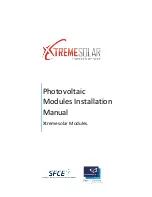
•
Do not wear rings, jewelry, watches, or other metallic items while working with photovoltaic modules.
4.0 MECHANICAL INSTALLATION
4.1 PLANNING AND DESIGN
• Before installation, check to ensure all sub-structure will accommodate expected system loads. This includes and is not
limited to roof, foundations, mechanical structure, and mechanical connections.
• For roof installations, utilize a fire-resistant roof covering rated for the application.
• Mechanical structures should not contact the module backsheet under any expected load conditions
• Consider the following factors during system design, which will influence performance:
a) MEMC solar modules produce the most power when they are pointed directly at the sun, and should be tilted for
optimum system performance.
b) Proximity to obstructions such as: walls, buildings, trees, groundcover, snow cover, or dust and debris that have the
potential to shade or damage the modules.
c) Elevated temperatures will decrease energy yield, so designs should ensure adequate airflow across the back of the module.
d) Allow a minimum spacing of 10 mm between modules for thermal expansion.
4.2 MODULE INSTALLATION OPTIONS FOR MOUNTING LOCATIONS
For mounting locations for clamps or bolt for specified load, please refer to Table on page 5.
• Each module should be mounted using four bolts through the mounting holes on the rear side of the module, or with four
clamps over the front side.
• Depending on the desired load capability of the array, modules may be mounted either perpendicular or parallel to the
structure rails. Clamps can be mounted anywhere inside of the safe mounting range for each case illustrated below (referring
to chart showing clamp and bolt mounting locations).
• If using bolts, four mounting holes are provided on the rear side the module frame as shown in Appendix 8.1. Use a stainless
steel bolt stack no smaller than ¼"-20 or M6, with two flat washers and a locking washer as shown in Appendix 8.2.
• To ensure an adequate clamping area, all clamps used must comply with the minimum clamping dimensions specified in
Appendix 8.3. All fasteners used to fix the modules with clamps should be stainless steel, and no smaller than ¼”-20 or M6.
• To provide adequate fixing or clamping force, torque the minimum recommended fasteners to 6.2 - 8.9 Nm (4.6 - 6.6 ft-lb).
• For all cases, the area of the supporting structure in contact with rear side of the module must comply with the minimum
support dimensions specified in Appendix 8.3.
• All other structural dimensions, such as clamp and rail thickness, should be sized appropriately for the intended site load.
4.3 MODULE INSTALLATION USING CENTER MOUNTING BRACKETS
• Modules may also be mounted using center clamps as shown in Appendix 8.2, for use with trackers.
• Module clamps for center mounting must be based on MEMC approved extrusion and hardware.
• For module loads higher than 2400 Pa, module clamps and hardware must be pre-approved by MEMC.
4.4 MECHANICAL INSTALLATION WARNINGS
• Installation and maintenance should be performed by qualified personnel only.
• Use insulated tools during installation, troubleshooting and maintenance of photovoltaic modules.
• Installers should adhere to all applicable local, regional, and national codes and regulations when designing and constructing
the photovoltaic system.
• Do not stand or walk on any surface of the modules. Do not place any objects or load on the surface of the modules.
Installation Manual: MEMC Silvantis P290 | M320
4 of 13
© Copyright 2012 MEMC Electronic Material
































